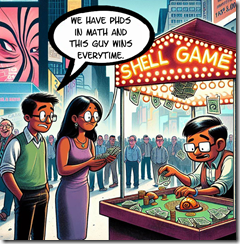IBM: AI Marketing Like It Was 2004
January 5, 2024
 This essay is the work of a dumb dinobaby. No smart software required. Note: The word “dinobaby” is — I have heard — a coinage of IBM. The meaning is an old employee who is no longer wanted due to salary, health care costs, and grousing about how the “new” IBM is not the “old” IBM. I am a proud user of the term, and I want to switch my tail to the person who whipped up the word.
This essay is the work of a dumb dinobaby. No smart software required. Note: The word “dinobaby” is — I have heard — a coinage of IBM. The meaning is an old employee who is no longer wanted due to salary, health care costs, and grousing about how the “new” IBM is not the “old” IBM. I am a proud user of the term, and I want to switch my tail to the person who whipped up the word.
What’s the future of AI? The answer depends on whom one asks. IBM, however, wants to give it the old college try and answer the question so people forget about the Era of Watson. There’s a new Watson in town, or at least, there is a new Watson at the old IBM url. IBM has an interesting cluster of information on its Web site. The heading is “Forward Thinking: Experts Reveal What’s Next for AI.”
IBM crows that it “spoke with 30 artificial intelligence visionaries to learn what it will take to push the technology to the next level.” Five of these interviews are now available on the IBM Web site. My hunch is that IBM will post new interviews, hit the new release button, post some links on social media, and then hit the “Reply” button.
Can IBM ignite excitement and capture the revenues it wants from artificial intelligence? That’s a good question, and I want to ask the expert in the cartoon for an answer. Unfortunately only customers and their decisions matter for AI thought leaders unless the intended audience is start ups, professors, and employees. Thanks, MSFT Copilot Bing thing. Good enough.
As I read the interviews, I thought about the challenge of predicting where smart software would go as it moved toward its “what’s next.” Here’s a mini-glimpse of what the IBM visionaries have to offer. Note that I asked Microsoft’s smart software to create an image capturing the expert sitting in an office surrounded by memorabilia.
Kevin Kelly (the author of What Technology Wants) says: “Throughout the business world, every company these days is basically in the data business and they’re going to need AI to civilize and digest big data and make sense out of it—big data without AI is a big headache.” My thought is that IBM is going to make clear that it can help companies with deep pockets tackle these big data and AI them. Does AI want something, or do those trying to generate revenue want something?
Mark Sagar (creator of BabyX) says: “We have had an exponential rise in the amount of video posted online through social media, etc. The increased use of video analysis in conjunction with contextual analysis will end up being an extremely important learning resource for recognizing all kinds of aspects of behavior and situations. This will have wide ranging social impact from security to training to more general knowledge for machines.” Maybe IBM will TikTok itself?
Chieko Asakawa (an unsighted IBM professional) says: “We use machine learning to teach the system to leverage sensors in smartphones as well as Bluetooth radio waves from beacons to determine your location. To provide detailed information that the visually impaired need to explore the real world, beacons have to be placed between every 5 to 10 meters. These can be built into building structures pretty easily today.” I wonder if the technology has surveillance utility?
Yoshua Bengio (seller of an AI company to ServiceNow) says: “AI will allow for much more personalized medicine and bring a revolution in the use of large medical datasets.” IBM appears to have forgotten about its Houston medical adventure and Mr. Bengio found it not worth mentioning I assume.
Margaret Boden (a former Harvard professor without much of a connection to Harvard’s made up data and administrative turmoil) says: “Right now, many of us come at AI from within our own silos and that’s holding us back.” Aren’t silos necessary for security, protecting intellectual property, and getting tenure? Probably the “silobreaking” will become a reality.
Several observations:
- IBM is clearly trying hard to market itself as a thought leader in artificial intelligence. The Jeopardy play did not warrant a replay.
- IBM is spending money to position itself as a Big Dog pulling the AI sleigh. The MIT tie up and this AI Web extravaganza are evidence that IBM is [a] afraid of flubbing again, [b] going to market its way to importance, [c] trying to get traction as outfits like OpenAI, Mistral, and others capture attention in the US and Europe.
- IBM’s ability to generate awareness of its thought leadership in AI underscores one of the challenges the firm faces in 2024.
Net net: The company that coined the term “dinobaby” has its work cut out for itself in my opinion. Is Jeopardy looking like a channel again?
Stephen E Arnold, January 5, 2024
Does Amazon Do Questionable Stuff? Sponsored Listings? Hmmm.
January 4, 2024
 This essay is the work of a dumb dinobaby. No smart software required.
This essay is the work of a dumb dinobaby. No smart software required.
Amazon, eBay, other selling platforms allow vendors to buy sponsored ads or listings. Sponsored ads or listings promote products and services to the top of search results. It’s similar to how Google sells ads. Unfortunately Google’s search results are polluted with more sponsored ads than organic results. Sponsored ads might not be a wise investment. Pluralistic explains that sponsored ads are really a huge waste of money: “Sponsored Listings Are A Ripoff For Sellers.”
Amazon relies on a payola sponsored ad system, where sellers bid to be the top-ranked in listings even if their products don’t apply to a search query. Payola systems are illegal but Amazon makes $31 billion annually from its system. The problem is that the $31 billion is taken from Amazon sellers who pay it in fees for the privilege to sell on the platform. Sellers then recoup that money from consumers and prices are raised across all the markets. Amazon controls pricing on the Internet.
Another huge part of a seller’s budget is for Amazon advertising. If sellers don’t buy ads in searches that correspond to their products, they’re kicked off the first page. The Amazon payola system only benefits the company and sellers who pay into the payola. Three business-school researchers Vibhanshu Abhishek, Jiaqi Shi and Mingyu Joo studied the harmful effects of payolas:
“After doing a lot of impressive quantitative work, the authors conclude that for good sellers, showing up as a sponsored listing makes buyers trust their products less than if they floated to the top of the results "organically." This means that buying an ad makes your product less attractive than not buying an ad. The exception is sellers who have bad products – products that wouldn’t rise to the top of the results on their own merits. The study finds that if you buy your mediocre product’s way to the top of the results, buyers trust it more than they would if they found it buried deep on page eleventy-million, to which its poor reviews, quality or price would normally banish it. But of course, if you’re one of those good sellers, you can’t simply opt not to buy an ad, even though seeing it with the little "AD" marker in the thumbnail makes your product less attractive to shoppers. If you don’t pay the danegeld, your product will be pushed down by the inferior products whose sellers are only too happy to pay ransom.”
It’s getting harder to compete and make a living on online selling platforms. It would be great if Amazon sided with the indy sellers and quit the payola system. That will never happen.
Whitney Grace, January 4, 2024
Ignoring the Big Thing: Google and Its PR Hunger
December 18, 2023
 This essay is the work of a dumb dinobaby. No smart software required.
This essay is the work of a dumb dinobaby. No smart software required.
I read “FunSearch: Making New Discoveries in Mathematical Sciences Using Large Language Models.” The main idea is that Google’s smart software is — once again — going where no mortal man has gone before. The write up states:
Today, in a paper published in Nature, we introduce FunSearch, a method to search for new solutions in mathematics and computer science. FunSearch works by pairing a pre-trained LLM, whose goal is to provide creative solutions in the form of computer code, with an automated “evaluator”, which guards against hallucinations and incorrect ideas. By iterating back-and-forth between these two components, initial solutions “evolve” into new knowledge. The system searches for “functions” written in computer code; hence the name FunSearch.
I like the idea of getting the write up in Nature, a respected journal. I like even better the idea of Google-splaining how a large language model can do mathy things. I absolutely love the idea of “new.”
“What’s with the pointed stick? I needed a wheel,” says the disappointed user of an advanced technology in days of yore. Thanks, MSFT Copilot. Good enough, which is a standard of excellence in smart software in my opinion.
Here’s a wonderful observation summing up Google’s latest development in smart software:
FunSearch is like one of those rocket cars that people make once in a while to break land speed records. Extremely expensive, extremely impractical and terminally over-specialized to do one thing, and do that thing only. And, ultimately, a bit of a show. YeGoblynQueenne via YCombinator.
My question is, “Is Google dusting a code brute force method with marketing sprinkles?” I assume that the approach can be enhanced with more tuning of the evaluator. I am not silly enough to ask if Google will explain the settings, threshold knobs, and probability levers operating behind the scenes.
Google’s prose makes the achievement clear:
This work represents the first time a new discovery has been made for challenging open problems in science or mathematics using LLMs. FunSearch discovered new solutions for the cap set problem, a longstanding open problem in mathematics. In addition, to demonstrate the practical usefulness of FunSearch, we used it to discover more effective algorithms for the “bin-packing” problem, which has ubiquitous applications such as making data centers more efficient.
The search for more effective algorithms is a never-ending quest. Who bothers to learn how to get a printer to spit out “Hello, World”? Today I am pleased if my printer outputs a Gmail message. And bin-packing is now solved. Good.
As I read the blog post, I found the focus on large language models interesting. But that evaluator strikes me as something of considerable interest. When smart software discovers something new, who or what allows the evaluator to “know” that something “new” is emerging. That evaluator must be something to prevent hallucination (a fancy term for making stuff up) and blocking the innovation process. I won’t raise any Philosophy 101 questions, but I will say, “Google has the keys to the universe” with sprinkles too.
There’s a picture too. But where’s the evaluator. Simplification is one thing, but skipping over the system and method that prevents smart software hallucinations (falsehoods, mistakes, and craziness) is quite another.
Google is not a company to shy from innovation from its human wizards. If one thinks about the thrust of the blog post, will these Googlers be needed. Google’s innovativeness has drifted toward me-too behavior and being clever with advertising.
The blog post concludes:
FunSearch demonstrates that if we safeguard against LLMs’ hallucinations, the power of these models can be harnessed not only to produce new mathematical discoveries, but also to reveal potentially impactful solutions to important real-world problems.
I agree. But the “how” hangs above the marketing. But when a company has quantum supremacy, the grimness of the recent court loss, and assorted legal hassles — what is this magical evaluator?
I find Google’s deal to use facial recognition to assist the UK in enforcing what appears to be “stop porn” regulations more in line with what Google’s smart software can do. The “new” math? Eh, maybe. But analyzing every person trying to access a porn site and having the technical infrastructure to perform cross correlation. Now that’s something that will be of interest to governments and commercial customers.
The bin thing and a short cut for a python script. Interesting but it lacks the practical “big bucks now” potential of the facial recognition play. That, as far as I know, was not written up and ponied around to prestigious journals. To me, that was news, not the FUN as a cute reminder of a “function” search.
Stephen E Arnold, December 18, 2023
Weaponizing AI Information for Rubes with Googley Fakes
December 8, 2023
 This essay is the work of a dumb dinobaby. No smart software required.
This essay is the work of a dumb dinobaby. No smart software required.
From the “Hey, rube” department: “Google Admits That a Gemini AI Demo Video Was Staged” reports as actual factual:
There was no voice interaction, nor was the demo happening in real time.
Young Star Wars’ fans learn the truth behind the scenes which thrill them. Thanks, MSFT Copilot. One try and some work with the speech bubble and I was good to go.
And to what magical event does this mysterious statement refer? The Google Gemini announcement. Yep, 16 Hollywood style videos of “reality.” Engadget asserts:
Google is counting on its very own GPT-4 competitor, Gemini, so much that it staged parts of a recent demo video. In an opinion piece, Bloomberg says Google admits that for its video titled “Hands-on with Gemini: Interacting with multimodal AI,” not only was it edited to speed up the outputs (which was declared in the video description), but the implied voice interaction between the human user and the AI was actually non-existent.
The article makes what I think is a rather gentle statement:
This is far less impressive than the video wants to mislead us into thinking, and worse yet, the lack of disclaimer about the actual input method makes Gemini’s readiness rather questionable.
Hopefully sometime in the near future Googlers can make reality from Hollywood-type fantasies. After all, policeware vendors have been trying to deliver a Minority Report-type of investigative experience for a heck of a lot longer.
What’s the most interesting part of the Google AI achievement? I think it illuminates the thinking of those who live in an ethical galaxy far, far away… if true, of course. Of course. I wonder if the same “fake it til you make it” approach applies to other Google activities?
Stephen E Arnold, December 8, 2023
Google Smart Software Titbits: Post Gemini Edition
December 8, 2023
 This essay is the work of a dumb dinobaby. No smart software required.
This essay is the work of a dumb dinobaby. No smart software required.
In the Apple-inspired roll out of Google Gemini, the excitement is palpable. Is your heart palpitating? Ah, no. Neither is mine. Nevertheless, in the aftershock of a blockbuster “me to” the knowledge shrapnel has peppered my dinobaby lair; to wit: Gemini, according to Wired, is a “new breed” of AI. The source? Google’s Demis Hassabis.
What happens when the marketing does not align with the user experience? Tell the hardware wizards to shift into high gear, of course. Then tell the marketing professionals to evolve the story. Thanks, MSFT Copilot. You know I think you enjoyed generating this image.
Navigate to “Google Confirms That Its Cofounder Sergey Brin Played a Key Role in Creating Its ChatGPT Rival.” That’s a clickable headline. The write up asserts: “Google hinted that its cofounder Sergey Brin played a key role in the tech giant’s AI push.”
Interesting. One person involved in both Google and OpenAI. And Google responding to OpenAI after one year? Management brilliance or another high school science club method? The right information at the right time is nine-tenths of any battle. Was Google not processing information? Was the information it received about OpenAI incorrect or weaponized? Now Gemini is a “new breed” of AI. The Verge reports that McDonald’s burger joints will use Google AI to “make sure your fries are fresh.”
Google has been busy in non-AI areas; for instance:
- The Register asserts that a US senator claims Google and Apple reveal push notification data to non-US nation states
- Google has ramped up its donations to universities, according to TechMeme
- Lost files you thought were in Google Drive? Never fear. Google has a software tool you can use to fix your problem. Well, that’s what Engadget says.
So an AI problem? What problem?
Stephen E Arnold, December 8, 2023
Gemini Twins: Which Is Good? Which Is Evil? Think Hard
December 6, 2023
 This essay is the work of a dumb dinobaby. No smart software required.
This essay is the work of a dumb dinobaby. No smart software required.
I received a link to a Google DeepMind marketing demonstration Web page called “Welcome to Gemini.” To me, Gemini means Castor and Pollux. Somewhere along the line — maybe a wonky professor named Chapman — told my class that these two represented Zeus and Hades. Stated another way, one was a sort of “good” deity with a penchant for non-godlike behavior. The other downright awful most of the time. I assume that Google knows about Gemini, its mythological baggage, and the duality of a Superman type doing the trust, justice, American way, and the other inspiring a range of bad actors. Imagine. Something that is good and bad. That’s smart software I assume. The good part sells ads; the bad part fails at marketing perhaps?
Two smart Googlers in New York City learn the difference between book learning for a PhD and street learning for a degree from the Institute of Hard Knocks. Thanks, MSFT Copilot. (Are you monitoring Google’s effort to dominate smart software by announcing breakthroughs very few people understand? Are you finding Google’s losses at the AI shell game entertaining?
Google’s blog post states with rhetorical aplomb:
Gemini is built from the ground up for multimodality — reasoning seamlessly across text, images, video, audio, and code.
Well, any other AI using Google’s previous technology is officially behind the curve. That’s clear to me. I wonder if Sam AI-Man, Microsoft, and the users of ChatGPT are tuned to the Google wavelength? There’s a video or more accurately more than a dozen of them, but I don’t like video so I skipped them all. There are graphs with minimal data and some that appear to jiggle in “real” time. I skipped those too. There are tables. I did read the some of the data and learned that Gemini can do basic arithmetic and “challenging” math like geometry. That is the 3, 4, 5 triangle stuff. I wonder how many people under the age of 18 know how to use a tape measure to determine if a corner is 90 degrees? (If you don’t, why not ask ChatGPT or MSFT Copilot.) I processed the twin’s size which come in three sizes. Do twins come in triples? Sigh. Anyway one can use Gemini Ultra, Gemini Pro, and Gemini Nano. Okay, but I am hung up on the twins and the three sizes. Sorry. I am a dinobaby. There are more movies. I exited the site and navigated to YCombinator’s Hacker News. Didn’t Sam AI-Man have a brush with that outfit?
You can find the comments about Gemini at this link. I want to highlight several quotations I found suggestive. Then I want to offer a few observations based on my conversation with my research team.
Here are some representative statements from the YCombinator’s forum:
- Jansan said: Yes, it [Google] is very successful in replacing useful results with links to shopping sites.
- FrustratedMonkey said: Well, deepmind was doing amazing stuff before OpenAI. AlphaGo, AlphaFold, AlphaStar. They were groundbreaking a long time ago. They just happened to miss the LLM surge.
- Wddkcs said: Googles best work is in the past, their current offerings are underwhelming, even if foundational to the progress of others.
- Foobar said: The whole things reeks of being desperate. Half the video is jerking themselves off that they’ve done AI longer than anyone and they “release” (not actually available in most countries) a model that is only marginally better than the current GPT4 in cherry-picked metrics after nearly a year of lead-time?
- Arson9416 said: Google is playing catchup while pretending that they’ve been at the forefront of this latest AI wave. This translates to a lot of talk and not a lot of action. OpenAI knew that just putting ChatGPT in peoples hands would ignite the internet more than a couple of over-produced marketing videos. Google needs to take a page from OpenAI’s playbook.
Please, work through the more than 600 comments about Gemini and reach your own conclusions. Here are mine:
- The Google is trying to market using rhetorical tricks and big-brain hot buttons. The effort comes across to me as similar to Ford’s marketing of the Edsel.
- Sam AI-Man remains the man in AI. Coups, tension, and chaos — irrelevant. The future for many means ChatGPT.
- The comment about timing is a killer. Google missed the train. The company wants to catch up, but it is not shipping products nor being associated to features grade school kids and harried marketers with degrees in art history can use now.
Sundar Pichai is not Sam AI-Man. The difference has become clear in the last year. If Sundar and Sam are twins, which represents what?
Stephen E Arnold, December 6, 2023
x
x
x
x
xx
Forget Deep Fakes. Watch for Shallow Fakes
December 6, 2023
 This essay is the work of a dumb dinobaby. No smart software required.
This essay is the work of a dumb dinobaby. No smart software required.
“A Tech Conference Listed Fake Speakers for Years: I Accidentally Noticed” revealed a factoid about which I knew absolutely zero. The write up reveals:
For 3 years straight, the DevTernity conference listed non-existent software engineers representing Coinbase and Meta as featured speakers. When were they added and what could have the motivation been?
The article identifies and includes what appear to be “real” pictures of a couple of these made-up speakers. What’s interesting is that only females seem to be made up. Is that perhaps because conference organizers like to take the easiest path, choosing people who are “in the news” or “friends.” In the technology world, I see more entities which appear to be male than appear to be non-males.
Shallow fakes. Deep fakes. What’s the problem? Thanks, MSFT Copilot. Nice art which you achieved exactly how? Oh, don’t answer that question. I don’t want to know.
But since I don’t attend many conferences, I am not in touch with demographics. Furthermore, I am not up to speed on fake people. To be honest, I am not too interested in people, real or fake. After a half century of work, I like my French bulldog.
The write up points out:
We’ve not seen anything of this kind of deceit in tech – a conference inventing speakers, including fake images – and the mainstream media covered this first-of-a-kind unethical approach to organizing a conference,
That’s good news.
I want to offer a handful of thoughts about creating “fake” people for conferences and other business efforts:
- Why not? The practice went unnoticed for years.
- Creating digital “fakes” is getting easier and the tools are becoming more effective at duplicating “reality” (whatever that is). It strikes me that people looking for a short cut for a diverse Board of Directors, speaker line up, or a LinkedIn reference might find the shortest, easiest path to shape reality for a purpose.
- The method used to create a fake speaker is more correctly termed ka “shallow” fake. Why? As the author of the cited paper points out. Disproving the reality of the fakes was easy and took little time.
Let me shift gears. Why would conference organizers find fake speakers appealing? Here are some hypotheses:
- Conferences fall into a “speaker rut”; that is, organizers become familiar with certain speakers and consciously or unconsciously slot them into the next program because they are good speakers (one hopes), friendly, or don’t make unwanted suggestions to the organizers
- Conference staff are overworked and understaffed. Applying some smart workflow magic to organizing and filling in the blanks spaces on the program makes the use of fakery appealing, at least at one conference. Will others learn from this method?
- Conferences have become more dependent on exhibitors. Over the years, renting booth space has become a way for a company to be featured on the program. Yep, advertising, just advertising linked to “sponsors” of social gatherings or Platinum and Gold sponsors who get to put marketing collateral in a cheap nylon bag foisted on every registrant.
I applaud this write up. Not only will it give people ideas about how to use “fakes.” It will also inspire innovation in surprising ways. Why not “fake” consultants on a Zoom call? There’s an idea for you.
Stephen E Arnold, December 6, 2023
Google Maps: Trust in Us. Well, Mostly
December 1, 2023
 This essay is the work of a dumb dinobaby. No smart software required.
This essay is the work of a dumb dinobaby. No smart software required.
Friday and December 1, 2023. I want to commemorate the beginning of the last month of what has been an exciting 2023. How exciting. How about a Google Maps’ story?
Navigate to “Google Maps Mistake Leaves Dozens of Families Stranded in the Desert”. Here’s the story: The outstanding and from my point of view almost unusable Google Maps directed a number of people to a “dreadful dirt path during a dust storm.”
“Mommy, says the teenage son, “I told you exactly what the smart map system said to do. Why are we parked in a tree?” Thanks, MSFT Copilot. Good enough art.
Hey, wait up. I thought Google had developed a super duper quantum smart weather prediction system. Is Google unable to cross correlate Google Maps with potential negative weather events?
The answer, “Who are you kidding?” Google appears to be in content marketing hyperbole “we are better at high tech” mode. Let’s not forget the Google breakthrough regarding material science. Imagine. Google’s smart software identified oodles of new materials. Was this “new” news? Nope. Computational chemists have been generating potentially useful chemical substances for — what is it now? — decades. Is the Google materials science breakthrough going to solve the problem of burned food sticking to a cookie sheet? Sure, I am waiting for the news release.
What’s up with the Google Maps?
The write up says:
Google Maps apologized for the rerouting disaster and said that it had removed that route from its platform.
Hey, that’s helpful. I assume it was a quantum answer to a “we’re smart” outfit.
I wish I had kept the folder which had my collection of Google Map news items. I do recall someone who drove off a cliff. I had my own notes about my trying to find Seymour Rubinstein’s house on a bright sunny day. The inventor of WordStar did not live in the Bay. That was the location of Mr. Rubinstein’s house, according to Google Maps. I did find the house, and I had sufficient common sense not to drive into the water. I had other examples of great mappiness, but, alas!, no longer.
Is directing a harried mother into a desert during a dust storm humorous? Maybe to some in Sillycon Valley. I am not amused. I don’t think the mother was amused because in addition to the disturbing situation, her vehicle suffered $5,000 in damage.
The question is, “Why?”
Perhaps Google’s incentive system is not aligned to move consumer products like Google Maps from “good enough” to “excellent.” And the money that could have been spent on improving Google Maps may be needed to output stories about Google’s smart software inventing new materials.
Interesting. Isn’t OpenAI and the much loved Microsoft leading the smart software mindshare race? I think so. Perhaps Maps’ missteps are signal about management misalignment and deep issues within the Alphabet Google YouTube inferiority complex?
Stephen E Arnold, December 1, 2023
Maybe the OpenAI Chaos Ended Up as Grand Slam Marketing?
November 28, 2023
 This essay is the work of a dumb dinobaby. No smart software required.
This essay is the work of a dumb dinobaby. No smart software required.
Yep, Q Star. The next Big Thing. “About That OpenAI Breakthrough” explains
OpenAI could in fact have a breakthrough that fundamentally changes the world. But “breakthroughs” rarely turn to be general to live up to initial rosy expectations. Often advances work in some contexts, not otherwise.
I agree, but I have a slightly different view of the matter. OpenAI’s chaotic management skills ended up as accidental great marketing. During the dust up and dust settlement, where were the other Big Dogs of the techno-feudal world? If you said, who? you are on the same page with me. OpenAI burned itself into the minds of those who sort of care about AI and the end of the world Terminator style.
In companies and organizations with “do gooder” tendencies, the marketing messages can be interpreted by some as a scientific fact. Nope. Thanks, MSFT Copilot. Are you infringing and expecting me to take the fall?
First, shotgun marriages can work out here in rural Kentucky. But more often than not, these unions become the seeds of Hatfield and McCoy-type Thanksgivings. “Grandpa, don’t shoot the turkey with birdshot. Granny broke a tooth last year.” Translating from Kentucky argot: Ideological divides produce craziness. The OpenAI mini-series is in its first season and there is more to come from the wacky innovators.
Second, any publicity is good publicity in Sillycon Valley. Who has given a thought to Google’s smart software? How did Microsoft’s stock perform during the five day mini-series? What is the new Board of Directors going to do to manage the bucking broncos of breakthroughs? Talk about dominating the “conversation.” Hats off to the fun crowd at OpenAI. Hey, Google, are you there?
Third, how is that regulation of smart software coming along? I think one unit of the US government is making noises about the biggest large language model ever. The EU folks continue to discuss, a skill essential to representing the interests of the group. Countries like China are chugging along, happily downloading code from open source repositories. So exactly what’s changed?
Net net: The OpenAI has been a click champ. Good, bad, or indifferent, other AI outfits have some marketing to do in the wake of the blockbuster “Sam AI-Man: The Next Bigger Thing.” One way or another, Sam AI-Man dominates headlines, right Zuck, right Sundar?
Stephen E Arnold, November 28, 2023
Predicting the Weather: Another Stuffed Turkey from Google DeepMind?
November 27, 2023
 This essay is the work of a dumb dinobaby. No smart software required.
This essay is the work of a dumb dinobaby. No smart software required.
By or design, the adolescents at OpenAI have dominated headlines for the pre-turkey, the turkey, and the post-turkey celebrations. In the midst of this surge in poohbah outputs, Xhitter xheets, and podcast posts, non-OpenAI news has been struggling for a toehold.
An important AI announcement from Google DeepMind stuns a small crowd. Were the attendees interested in predicting the weather or getting a free umbrella? Thank, MSFT Copilot. Another good enough art work whose alleged copyright violations you want me to determine. How exactly am I to accomplish that? Use, Google Bard?
What is another AI company to do?
A partial answer appears in “DeepMind AI Can Beat the Best Weather Forecasts. But There Is a Catch”. This is an article in the esteemed and rarely spoofed Nature Magazine. None of that Techmeme dominating blue link stuff. None of the influential technology reporters asserting, “I called it. I called it.” None of the eye wateringly dorky observations that OpenAI’s organizational structure was a problem. None of the “Satya Nadella learned about the ouster at the same time we did.” Nope. Nope. Nope.
What Nature provided is good, old-fashioned content marketing. The write up points out that DeepMind says that it has once again leapfrogged mere AI mortals. Like the quantum supremacy assertion, the Google can predict the weather. (My great grandmother made the same statement about The Farmer’s Almanac. She believed it. May she rest in peace.)
The estimable magazine reported in the midst of the OpenAI news making turkeyfest said:
To make a forecast, it uses real meteorological readings, taken from more than a million points around the planet at two given moments in time six hours apart, and predicts the weather six hours ahead. Those predictions can then be used as the inputs for another round, forecasting a further six hours into the future…. They [Googley DeepMind experts] say it beat the ECMWF’s “gold-standard” high-resolution forecast (HRES) by giving more accurate predictions on more than 90 per cent of tested data points. At some altitudes, this accuracy rose as high as 99.7 per cent.
No more ruined picnics. No weddings with bridesmaids’ shoes covered in mud. No more visibly weeping mothers because everyone is wet.
But Nature, to the disappointment of some PR professionals presents an alternative viewpoint. What a bummer after all those meetings and presentations:
“You can have the best forecast model in the world, but if the public don’t trust you, and don’t act, then what’s the point? [A statement attributed to Ian Renfrew at the University of East Anglia]
Several thoughts are in order:
- Didn’t IBM make a big deal about its super duper weather capabilities. It bought the Weather Channel too. But when the weather and customers got soaked, I think IBM folded its umbrella. Will Google have to emulate IBM’s behavior. I mean “the weather.” (Note: The owner of the IBM Weather Company is an outfit once alleged to have owned or been involved with the NSO Group.)
- Google appears to have convinced Nature to announce the quantum supremacy type breakthrough only to find that a professor from someplace called East Anglia did not purchase the rubber boots from the Google online store.
- The current edition of The Old Farmer’s Almanac is about US$9.00 on Amazon. That predictive marvel was endorsed by Gussie Arnold, born about 1835. We are not sure because my father’s records of the Arnold family were soaked by sudden thunderstorm.
Just keep in mind that Google’s system can predict the weather 10 days ahead. Another quantum PR moment from the Google which was drowned out in the OpenAI tsunami.
Stephen E Arnold, November 27, 2023











